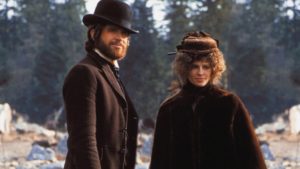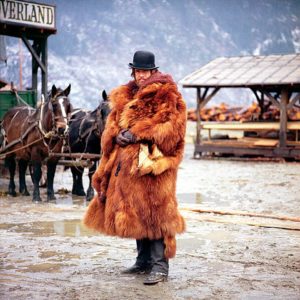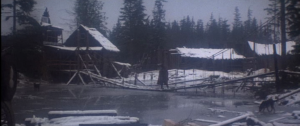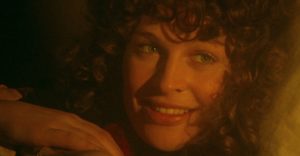 Attend: Program Notes
Attend: Program Notes
McCabe & Mrs. Miller | Robert Altman | US | 1971 | 121 minutes
Cinesthesia, Madison Public Library Central Branch, Thursday, February 1, 6:30pm»
In his Cinesthesia program notes, Jason Fuhrman explains how Robert Altman took the tragic tale of a stubborn gambler and a feisty madam and reinvented the modern western with his 1971 classic, McCabe & Mrs. Miller.
Director Robert Altman breathed life into a dead genre and blazed a trail for a new kind of cinematic naturalism with his brilliant revisionist western, McCabe & Mrs. Miller.
Adapted from Edmund Naughton’s 1959 novel McCabe, the film tells the tragic story of John McCabe (Warren Beatty), a brash, itinerant gambler who arrives in the crude Pacific Northwest mining town of Presbyterian Church. He announces his intention to open a brothel and promptly begins to transform this bleak little settlement on the fringe of civilization. Constance Miller (Julie Christie), a tough Cockney madam, soon becomes his unlikely business partner after convincing him that he needs a competent manager. She insists on importing more desirable women from Seattle and improving their accommodations out of concern for hygiene. As their joint venture thrives, the pair develop an increasingly complex and ambiguous relationship.
Their endeavor—and their lives—are endangered when representatives of a powerful, ruthless mining company approach McCabe one evening and offer to purchase his holdings in the town. He flatly rejects their proposal and therefore ensures his downfall.
With its unusual setting, diffusely structured narrative, vividly three-dimensional characters, and innovative cinematography, McCabe & Mrs. Miller neither looks nor feels like any other western. Altman playfully discards genre conventions as he presents an impressionistic, exceptionally honest vision of frontier life at the turn of the century. The maverick director imbues his radical western with grit and poetic realism. He demythologizes and defamiliarizes the most beloved of American genres, while focusing on the minute details of daily existence in the Old West. His painstaking devotion to verisimilitude extends to every aspect of the film. McCabe & Mrs. Miller powerfully evokes the cruelty and desperation of the period, yet Altman extracts traces of fleeting beauty from this stark landscape.
“I don’t like westerns,” Altman once declared. “I don’t like the obvious lack of truth in them.” The director had wanted to make an unorthodox western for a long time, and McCabe & Mrs. Miller came to him through fortuitous coincidence.
 Producer David Foster purchased the rights to Naughton’s novel in 1968. Foster attempted unsuccessfully to interest both John Huston and Roman Polanski in making a film version before he was approached by Altman’s agent, George Litto, who conveyed Altman’s desire to make what he called “a western that wasn’t a western.” For his part, Altman understood that McCabe would provide the solid foundation he needed to “mess around in the corners and details and tell the story in a different way,” as he put it in the director’s commentary to the DVD edition. Altman and his occasional collaborator Brian McKay co-wrote a screen adaptation, originally titled The Presbyterian Church Wager, referring to a bet by a few of the townsfolk over whether McCabe would be killed after refusing to sell his assets. Under Altman’s supervision, a series of collaborators, including Beatty and Christie, rewrote the script to highlight McCabe’s irresponsibility, expand the title role of Constance Miller, and develop the various secondary characters who populate the town of Presbyterian Church.
Producer David Foster purchased the rights to Naughton’s novel in 1968. Foster attempted unsuccessfully to interest both John Huston and Roman Polanski in making a film version before he was approached by Altman’s agent, George Litto, who conveyed Altman’s desire to make what he called “a western that wasn’t a western.” For his part, Altman understood that McCabe would provide the solid foundation he needed to “mess around in the corners and details and tell the story in a different way,” as he put it in the director’s commentary to the DVD edition. Altman and his occasional collaborator Brian McKay co-wrote a screen adaptation, originally titled The Presbyterian Church Wager, referring to a bet by a few of the townsfolk over whether McCabe would be killed after refusing to sell his assets. Under Altman’s supervision, a series of collaborators, including Beatty and Christie, rewrote the script to highlight McCabe’s irresponsibility, expand the title role of Constance Miller, and develop the various secondary characters who populate the town of Presbyterian Church.
For Altman’s revisionist purposes, a fresh approach to the background was vital. In The Cinema of Robert Altman: Hollywood Maverick, Robert Niemi observes, “Over the course of many decades, the western film genre had spawned a stable of endlessly repeated visual and thematic clichés that have reduced the enormously complex history of the Old West to stock cowboys, Indians, sheriffs, cattlemen and gunfighters battling it out in some dusty town near Monument Valley under the eternal summer sun.”
McCabe & Mrs. Miller, by contrast, takes place in autumn and winter among the densely forested mountains of the rainy Pacific Northwest, hundreds of miles from the nearest desert. Whereas traditional westerns tend to ignore America’s cultural and ethnic diversity, Altman aims for a more accurate representation of late-nineteenth century demographics. The inhabitants of Presbyterian Church consist of first-generation European immigrants, Chinese laborers, and even a middle-class African-American couple. Cowboy hats are conspicuously absent from the movie (with one exception).
Altman brought the cast and crew to a remote location about forty miles from Vancouver, British Columbia. A vast collection of period western clothes was sent up and all the actors selected their own wardrobes, which they had to wear for the entire shoot, as well as mend themselves. Production designer Leon Ericksen constructed the sets from scratch according to specific historical parameters and Altman began shooting before they were completed, so that the town gradually emerges before our eyes. The crew and even some of the actors slept in the unfinished buildings. Local craftsmen employed by Altman also exchanged their power tools for chronologically appropriate hammers and screwdrivers.
 Working with cinematographer Vilmos Zsigmond, Altman sought to achieve a hazy visual effect in McCabe & Mrs. Miller. He did everything to destroy the clarity of the film, thus “creating the impression that one is viewing it through a pane of stained glass,” in the words of Nathaniel Rich. Altman placed fog filters over the cameras to desaturate the colors. He and Szigmond experimented with “flashing,” exposing the negatives to light before they were developed, effectively sabotaging the film stock so that the studio would have no choice but to accept it. “I wanted it to have that antique, historical look,” the director told David Thompson in an interview. “I really set out to make it look like those old photographs do.” Although such photographs are obviously black and white, Altman thought color was more truthful “since no one sees in black and white.” Thus, he attempted to emulate what a faded color photograph from those days might look like.
Working with cinematographer Vilmos Zsigmond, Altman sought to achieve a hazy visual effect in McCabe & Mrs. Miller. He did everything to destroy the clarity of the film, thus “creating the impression that one is viewing it through a pane of stained glass,” in the words of Nathaniel Rich. Altman placed fog filters over the cameras to desaturate the colors. He and Szigmond experimented with “flashing,” exposing the negatives to light before they were developed, effectively sabotaging the film stock so that the studio would have no choice but to accept it. “I wanted it to have that antique, historical look,” the director told David Thompson in an interview. “I really set out to make it look like those old photographs do.” Although such photographs are obviously black and white, Altman thought color was more truthful “since no one sees in black and white.” Thus, he attempted to emulate what a faded color photograph from those days might look like.
Altman’s audacious use of sound and music was a key element in his subversive approach to the genre. He recorded multiple actors with personal microphones and assigned each microphone to a different track, allowing him to select which voices to make audible and which to muffle. The resultant mix of ambient noise and overlapping dialogue lends an intricate, lifelike texture to the many ensemble scenes. “You don’t need to hear everything people are saying to know the world they’re living in,” Altman said.
As for music, Altman eschewed the lush orchestral score typical of western epics in favor of diegetic music played by a fiddler and non-diegetic music by Leonard Cohen. McCabe & Mrs. Miller features three tracks from the Canadian poet and songwriter’s first album, Songs of Leonard Cohen, released in 1967: “Winter Lady,” “Sisters of Mercy,” and “The Stranger Song.” Cohen’s ethereal, melancholy ballads serve as musical themes and uncannily fit the mood of the film, as though they were specifically written for it.

At once a bold exercise in genre deconstruction, a savage indictment of industrial capitalism, a dreamlike evocation of unrequited love, and a timeless work of cinematic poetry, Altman’s existential horse opera remains the ideal showcase for his iconoclastic style. Nathaniel Rich asserts, “Altman did not so much reproduce a lost past as create a new world, with its own logic and texture. This is the source of the film’s honesty, which is to say its beauty.” McCabe & Mrs. Miller reinvents the western genre and elevates it to previously unimaginable aesthetic heights. It also works as a model for critically examining the realities of contemporary American culture. Robert T. Self notes that the film explores “the role of myth in the sustenance of American identity, the economic exploitations of corporate capitalism, the power of desire within the sublime of nature and the seduction of drugs, the potential of artistic discourse within the mass productions of Hollywood.”
At the time of its release, McCabe & Mrs. Miller was described by John Wayne as “corrupt.” The film was a box-office failure, but it has become one of Altman’s most enduring critical successes. In her New Yorker review, Pauline Kael praised it as “a beautiful pipe dream of a movie—a fleeting, almost diaphanous vision of what frontier life might have been.” Roger Ebert added it to his “Great Movies” list and stated, “Robert Altman has made a dozen films that can be called great in one way or another, but one of them is perfect, and that one is McCabe & Mrs. Miller.” In 2010, McCabe & Mrs. Miller was selected by the Library of Congress for preservation in the National Film Registry as being “culturally, historically or aesthetically” significant.